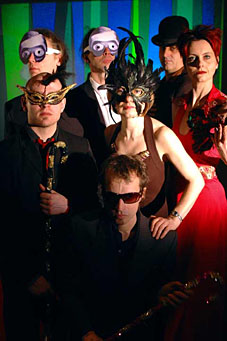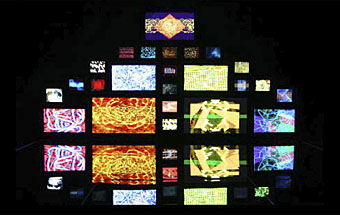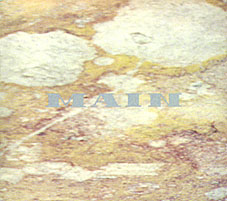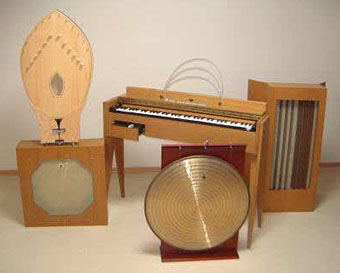At Wikipedia.
At 120 Years of Electronic Music.
At Peter Pringle’s site.
Category: {electronica}
Electronic music
The Photophonic Experiment
 Electric light orchestra
Electric light orchestra
Light bulbs. Biscuits. A 10,000-volt charge. The only thing you won’t find making music at a Photophonic Experiment gig is guitars and pianos, says Maddy Costa.
Maddy Costa
Friday, October 20, 2006
The Guardian
Ceinws in north Wales is the kind of tiny, bucolic town where nothing unusual is supposed to happen. And possibly it didn’t before Mark Anderson moved in. A sound-artist, instrument-maker and pyrotechnic with the performance group Blissbody, he has a workshop opposite the village pub that appears perfectly innocent from the outside, but inside could pass for a laboratory from a Frankenstein movie. Glass tubes and dangerous-looking electrical contraptions clutter the floor. Wires coil across a table. A standing lamp looms in the corner. “Watch this,” says Anderson, as excited as a five-year-old setting fire to a box of tissues. He points a mysterious black cone at the lamp and turns a dimmer switch to activate the bulb. Slowly, the lamp illuminates, and a sound fills the room: a low buzz at first, but growing painfully high-pitched as the light reaches full brightness. This really is white noise.
Remarkably, what Anderson is demonstrating isn’t an instrument of torture but a “photo-synth”, a device that converts light into sound. It’s a key element of the Photophonic Experiment, a bizarre, potentially fascinating collaboration between Anderson and like-minded musicians Pram and Kirsten Reynolds that tours the UK from next week. And if the people of Ceinws think Anderson is odd, they should hear what his associates get up to.
Generative culture

77 Million Paintings by Brian Eno, Laforet Museum, Harajuku, Tokyo.
Brian Eno is in the latest Wire talking about his forthcoming DVD-ROM, 77 Million Paintings. He also mentions coining the term “generative music” in 1995 to a resounding silence. 77 Million Paintings continues the generative project:
This will be available later in the year as a DVD-ROM (which will play on most modern computers) and a DVD featuring Brian talking about the project. It also includes an extensive booklet covering Brian’s long and successful career as a visual artist.
The name 77 Million Paintings comes from the possible number of images that can be created from a huge number of combinations. Anyone familiar with Brian’s audio-visual installations will instantly recognise the inspiration behind the project. The music is from Brian’s installation collection.
Ambient stuff for the eyes, in other words. I’d be looking forward to this if I still had a TV (mine packed up a few years ago) as I used to program my primitive Spectrum computer (which still works!) to generate simple patterns, turning the TV screen into an abstract artwork for a few hours. The difference with Eno’s project, of course, is the greater variety, quality and degree of intent involved. I saw one of his installation works, The Quiet Club, at the Hayward Gallery in 2000 which used similar audio and visual processes. With 77 Million Paintings you’ll be able to turn your living room into a quiet club of your own.
In a similar generative vein, there’s WolframTones: “A New Kind of Music – Unique cellphone ringtones created by simple programs from renowned scientist Stephen Wolfram’s computational universe.” Too complicated to explain; go and play around with it.
Main
 It’s the same every year, the weather gets hot (30C today) and out come the Main CDs, although the march of progress has meant importing them into iTunes this time round. For some reason Main’s Hz collection (6 EPs, later a double-disc set) is especially suited to warm temperatures, partly due to remembrance of them being released one a month during the hot summer of 1995.
It’s the same every year, the weather gets hot (30C today) and out come the Main CDs, although the march of progress has meant importing them into iTunes this time round. For some reason Main’s Hz collection (6 EPs, later a double-disc set) is especially suited to warm temperatures, partly due to remembrance of them being released one a month during the hot summer of 1995.
Main seem somewhat neglected now despite being in the vanguard of a particular brand of ambient abstraction that emerged throughout the 1990s. To redress the balance slightly, here’s a David Toop interview from The Wire conducted just as the Hz project was getting underway.
Main‘s multi-layered, mud-encrusted textures suggest everything from radio interference to insect chatter. The group’s Robert Hampson talks to David Toop about reinventing the guitar and the mystery of electroacoustics.
DRAW A STRAIGHT LINE on sand, water, skin, steam (and follow it). Main is texture: the interiority of the guitar. The electric, effects-augmented guitar is transitional technology, a mid-point between the dextrous physicality of traditional instruments and the imaginative space of the electronic studio. But also a return to the untempered crystal world of harmonic complexity, a reversal of the pure, precise clarity of classical acoustic guitar, back into the droning resonant strings of an Indian tamboura, bottle tops rattling on a Shona thumb piano, or spider’s egg sacs buzzing on gourd resonators lashed under a Central African xylophone.
New Monolake
Alaska Melting, vinyl-only release
by my favourite electronic artist.


